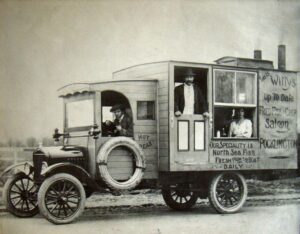‘TO SHIELD THE WEAK AND BIND THE STRONG’
The Story of The Wolds Wagoners by Trish Wade
If you should travel through the village of Sledmere in East Yorkshire you will see, beside the road, two memorials. The smaller one of these is known as the Wagoner’s Memorial commissioned to remember a band of farm workers from Sledmere Estate and the surrounding farms in the area who pledged an oath of loyalty to the crown before the outbreak of the First World War. This is the story of The Wolds Wagoners.
It was the foresight of Sit Mark Sykes 6th Baronet of Sledmere House who, in the early part of 1913, realised that should there be another war the army would have a shortage of skilled horse transport drivers. Sir Mark had the inspiration to see that the knowledge and skill that the men who worked with the horses on the farm, driving pole wagons, would make the ideal army horse transport drivers. Eventually the War Office agreed with him and so was set up the ‘Wagoner’s Special Reserve’.
By July 1913 some 400 volunteers had been recruited and following a meeting before Christmas at the Pigeon Pie Hotel, Sherburn, another 21 had joined. Similar meetings took place in the area and proved to be very successful, eventually enlisting over 1,200 men. There were three categories of Wagoner, at the very top were Roadmasters (12 in number) who received an annual payment of £4, the Foreman (56) £2 and then the Wagoners (960) who received £1 and a further £1 for each subsequent year he re-joined. They had to take the oath of allegiance but received no military training at all during peace time.
To many, these men and boys may have seemed to be a but slow and steady, but these fellows had spent most of their lives on farms and when it came to handling a team of horses and wagons, they would have no equal. Before the war broke out, to maintain the enthusiasm of the Reserve, driving competition started to be held at local shows in the area. As the Reserve grew it became necessary to hold eliminating tests. However, the finals always took place at Fimber, near Sledmere. In July 1913 there was between forty and fifty teams competing. Part of the competition included being able to drive a figure eight course, dismantle and reassemble the wheels and axles from the wagons, harness up the horses and unload fifty-pound sacks against the clock. There was up to two thousand spectators at this event.

When war broke out in 1914 the Reserve was mobilised within two days, many of the men receiving their mobilisation papers whilst in the harvest fields (causing a great shortage of labour at harvest time). They had to report to the barracks at Bradford Moor by 6pm that same day. Once they had been called up they received pay of one shilling a day, plug an extra sixpence for proficiency. Once they had been sent out to France they drove the supply wagons of food, fodder and ammunition to the front line working, at times, under horrendous condition in wet, deep boggy mud. This was where their experience and expert handling of the horses and wagons came into its own ‘and it is true to state that the farm hands from the Yorkshire Wolds gave of the best – their skill 0 and proved themselves to be excellent transport drivers’ Sir John Forescue.
At the end of the war there were eighty men who did not return home. Sir Mark commissioned the memorial to the Wagoner’s in remembrance of those brave men but when he died in 1919 he never lived to see it’s completion.
Sir Mark will always be remembered for his foresight in being instrumental in raising the Corps of Wagoner’s, whose members were ready when they were most wanted.
The verses on the memorial all finish with the line ‘To shield the weak and bind the strong’.



